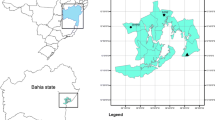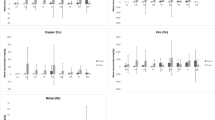Abstract
Lead (Pb) is a wide spread contaminant in the terrestrial landscape. It is highly detrimental to plant and animal life and possesses no known biologic function. Yet there is a paucity of reliable information available on the response of Australian and other plant species to Pb exposure at phytotoxic doses. In this study, the response of three Australian native grass species and two tree species to Pb in nutrient solution culture was investigated. Plants were exposed to average Pb concentrations ranging from 0.020 to 15.2 μM. The plant species included Acacia decurrens, Austrodanthonia richardsonii, Bothriochloa macra, Eucalyptus camaldulensis, and Dichanthium sericeum. Few foliar symptoms were evident in any plant species, although some discolouration in young leaves of E. camaldulensis was evident from 1 μM, and B. macra showed pronounced reddening at the highest treatments. The most tolerant plant species studied based on solution EC50, roots (μM) results was B. macra (7.0 ± 0.2), followed by A. decurrens (3.9 ± 0.2), D. sericeum (2.9 ± 0.3), E. camaldulensis (1.1 ± 0.3), and A. richardsonii (0.4). A hazardous concentration value (HC5) (n = 9) for soil solution was estimated to be 0.16 μM. A. richardsonii was highly sensitive to Pb and possessed little ability to restrict Pb translocation to its shoots. B. macra was able to tolerate high root (3924 mg kg−1) and shoot (743.0 mg kg−1) Pb concentrations. A. decurrens excluded Pb from it shoots. The high tolerance of A. decurrens to Pb and limited translocation to shoots indicates it may be useful in revegetation of Pb-contaminated soils.


Similar content being viewed by others
References
Adriano DC (2001) Trace elements in the environment: biogeochemistry, bioavailability, and risks of metals. Springer, New York, NY
Aldenberg T, Jaworska JS (2000) Uncertainty of the hazardous concentration and fraction affected for normal species sensitivity distributions. Ecotoxicol Environ Saf 46:1–18
Antosiewicz DM (2005) Study of calcium-dependent lead tolerance on plants differing in their level of Ca-deficiency tolerance. Environ Pollut 134:23–34
Archer JG, Caldwell RA (2004) Response of six Australian plant species to heavy metal contamination at an abandoned mine. Water Air Soil Pollut 157:257–267
Arriagada CA, Herrera MA, Ocampo JA (2005) Contribution of arbuscular mycorrhizal and saprobe fungi to the tolerance of Eucalyptus globulus to Pb. Water Air Soil Pollut 166:31–47
Asher CJ, Loneragan JF (1967) Response of plants to phosphate concentration in solution culture. Part 1. Growth and phosphorus content. Soil Sci 103:225–233
Barzi F, Naidu R, McLaughlin MJ (1996) Contaminants in the Australian environment. In: Naidu R, Kookana RS, Oliver DP, Rogers S, McLaughlin MJ (eds) Contaminants and the soil environment in the Australasia-Pacific region: proceedings of the first conference on contaminants and soil environment in the Australasia-Pacific region, Adelaide, Australia, 18–23 February, pp 451–484
Efroymson RA, Will ME, Suter GW II, Wooten AC (1997) Toxicological benchmarks for screening contaminants of potential concern for effects of terrestrial plans: 1997 revision. United States Department of Energy, Oak Ridge, TN
Elliot HA, Liberati MR, Huang CP (1986) Competitive adsorption of heavy metals by soils. J Environ Qual 15:214–219
Grant CD, Campbell CJ, Charnock NR (2002) Selection of species suitable for derelict mine site rehabilitation in New South Wales, Australia. Water Air Soil Pollut 139:215–235
Kachenko AG, Singh B, Bhatia NP (2007) Heavy metal tolerance in common fern species. Aust J Bot 55:63–73
Kim KR, Owens G, Naidu R (2009) Heavy metal distribution, bioaccessibility, and phytoavailability in long-term contaminated soils from Lake Macquarie, Australia. Aust J Soil Res 47:166–167
Kopittke PM, Asher CJ, Blamey FPC, Menzies NW (2007a) Toxic effects of Pb2+ on the growth and mineral nutrition of signal grass (Brachiaria decumbens) and Rhodes grass (Chloris gayana). Plant Soil 300:127–136
Kopittke PM, Asher CJ, Kopittke RA, Menzies NW (2007b) Toxic effects of Pb2+ on growth of cowpea (Vigna unguiculata). Environ Pollut 150:280–287
Kopittke PM, Asher CJ, Menzies NZ (2008a) Prediction of Pb speciation in concentrated and dilute nutrient solutions. Environ Pollut 153:548–554
Kopittke PM, Asher CJ, Blamey FPC, Auchterlonie GJ, Guo YN, Menzies NW (2008b) Localisation and chemical speciation in roots of Signal grass (Brachiaria decumbens) and Rhodes grass (Chloris gayana). Environ Sci Technol 42:4595–4599
Lamb DT, Ming H, Megharaj M, Naidu R (2009a) Heavy metal (Cu, Zn, Cd and Pb) partitioning and bioaccessibility in uncontaminated and long-term contaminated soils. J Haz Mat 171:1150–1158
Lamb DT, Ming H, Megharaj M, Naidu R (2009b) Relative tolerance of a range of Australian native plant species and lettuce to copper, zinc, cadmium and lead. Arch Environ Contam Toxicol (submitted)
Lindsay WL (2001) Chemical equilibria in soil. Blackburn Press, Caldwell, NJ
Liu W, Zhou Q, Zhang Y, Wei S (2009) Lead accumulation in different Chinese cabbage cultivars and screening for pollution-safe cultivars. J Environ Manage 91:781–788
Lottermoser BG, Ashley PM, Munksgaard NC (2008) Biogeochemistry of Pb-Zn gossans, northwest Queensland, Australia: Implications for mineral exploration and mine site rehabilitation. Appl Geochem 23:723–742
Martínez CE, Jacobson AR, McBride MB (2004) Lead phosphate minerals: Solubility and dissolution by model and natural ligands. Environ Sci Technol 38:5584–5590
McBride MB (1994) Environmental chemistry of soils. Oxford University Press, New York NY
McBride MB, Suavé S, Hendershot W (1997) Solubility control of Cu, Zn, Cd and Pb in contaminated soils. Euro J Soil Sci 48:337–346
Moorby H, Nye PH (1983) A nutrient film technique for the simultaneous measurement of root growth and nutrient uptake. Plant Soil 70:151–154
National Environmental Protection Council (1999) Schedule B(5) guideline on ecological risk assessment. Australian Government, Canberra, Australia
National Research Council (United States) (2005) Mineral tolerance of animals. National Academy of Sciences, Washington, DC
Nriagu JO (1973) Lead orthophosphates-II. Stability of chloropyromorphite at 25°C. Geochim Cosmochim Acta 37:367–377
Orlic I, Siegele R, Menon DD, Markich SJ, Cohen DD, Jefree RA et al (2002) Heavy metal pathways and archives in biological tissue. Nucl Instrum Methods Phys Res B 190:439–444
Påhlsson AB (1989) Toxicity of heavy metals (Zn, Cu, Cd, Pb) to vascular plants: a literature review. Water Air Soil Pollut 47:287–319
Parkhurst DL, Appelo CAJ (1999) User’s guide to PHREEQC (Version 2)―a computer program for speciation, batch-reaction, one-dimensional transport, and inverse geochemical calculations. United States Department of the Interior, United States Geological Survey. Available at: http://wwwbrr.cr.usgs.gov/projects/GWC_coupled/phreeqc/. Accessed October 2006
Shaw BP, Prasad MNV, Jha VK, Sahu BB (2006) Detoxification/defense mechanisms in metal-exposed plants. In: Prasad MNV, Sajwan KS, Naidu R (eds) Trace elements in the environment. Biogeochemistry, biotechnology and bioremediation. CRC Press, Boca Raton, FL
Strantforth R, Qiu J (2001) Effect of phosphate treatment on the solubility of lead in contaminated soil. Environ Geol 41:1–10
Wierzbicka M, Antosiewicz D (1993) How lead can easily enter the food chain—a study of plant roots. Sci Total Environ 134(Suppl):423–429
Wong MH (2003) Ecological restoration of mine degraded soils, with emphasis on metal contaminated soils. Chemosphere 50:775–780
Wong MH, Bradshaw AD (1982) A comparison of the toxicity of heavy metals, using root elongation of Rye grass, Lolium perenne. New Phytol l 91:255–261
Xie L, Giammar DE (2007) Equilibrium solubility and dissolution rate of the lead phosphate chloropyromorphite. Environ Sci Technol 41:8050–8055
Xiong ZT, Zhao F, Li M (2006) Lead toxicity in Brassica pekinensis Rupr.: Effect on nitrate assimilation and growth. Environ Toxicol 21:147–153
Zhang P, Ryan JA (1999) Transformation of Pb(II) for cerrusite to chloropyromorphite in the presence of hydroxyapatite under varying conditions of pH. Environ Sci Technol 33:625–630
Acknowledgements
This study was funded by the Australian Postgraduate Award (Industry), the Australian Commonwealth Government through the Australian Research Council, and the Cooperative Research Centre for Contamination Assessment and Remediation of the Environment.
Author information
Authors and Affiliations
Corresponding author
Rights and permissions
About this article
Cite this article
Lamb, D.T., Ming, H., Megharaj, M. et al. Phytotoxicity and Accumulation of Lead in Australian Native Vegetation. Arch Environ Contam Toxicol 58, 613–621 (2010). https://doi.org/10.1007/s00244-009-9460-2
Received:
Accepted:
Published:
Issue Date:
DOI: https://doi.org/10.1007/s00244-009-9460-2




